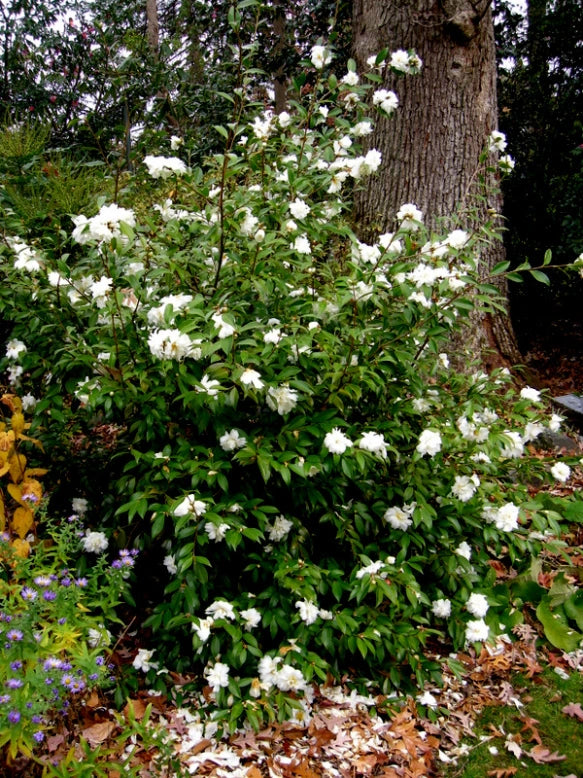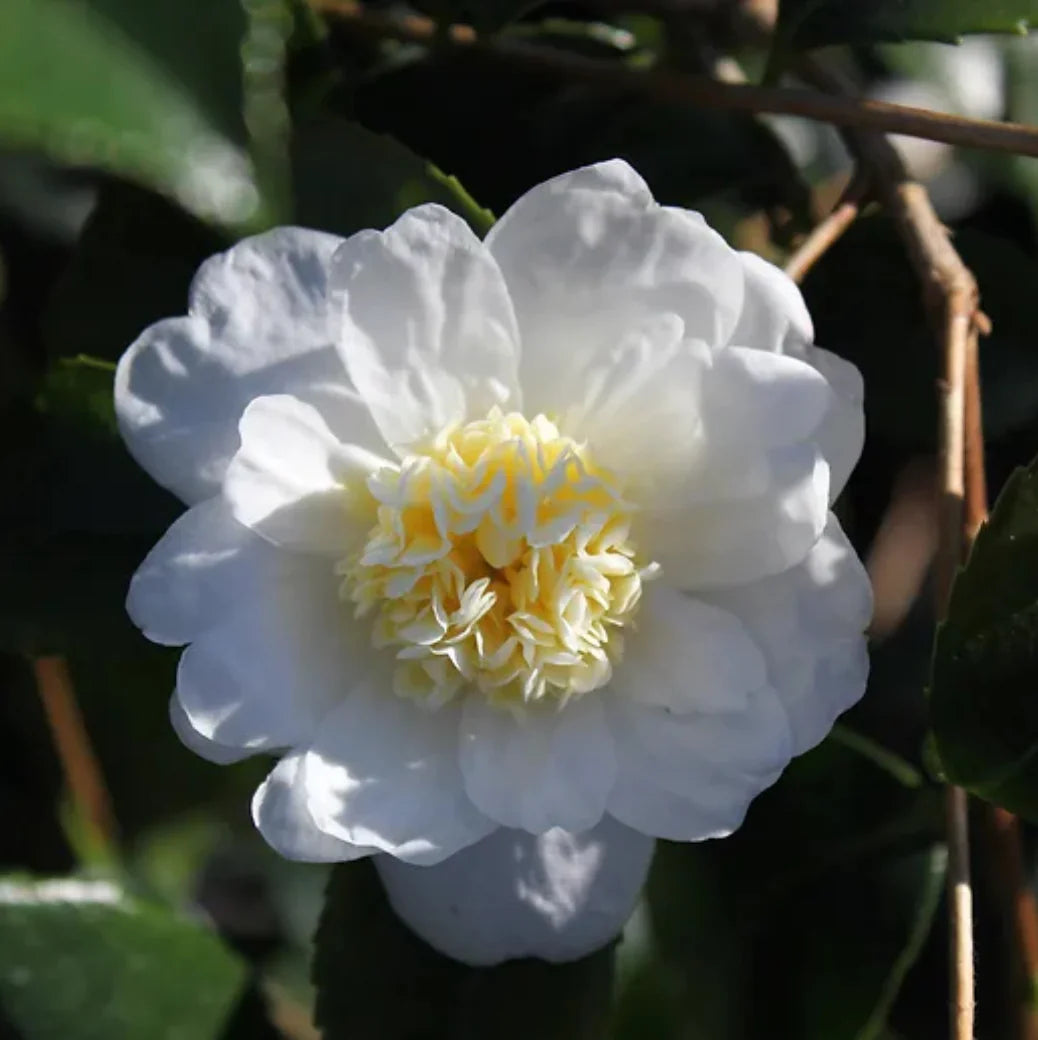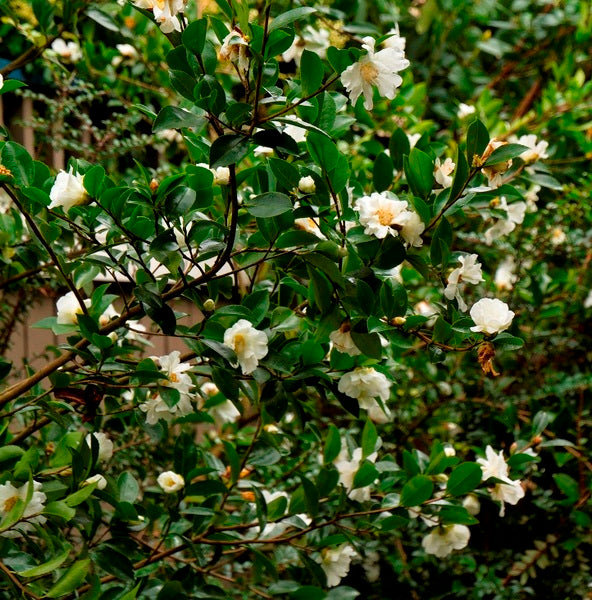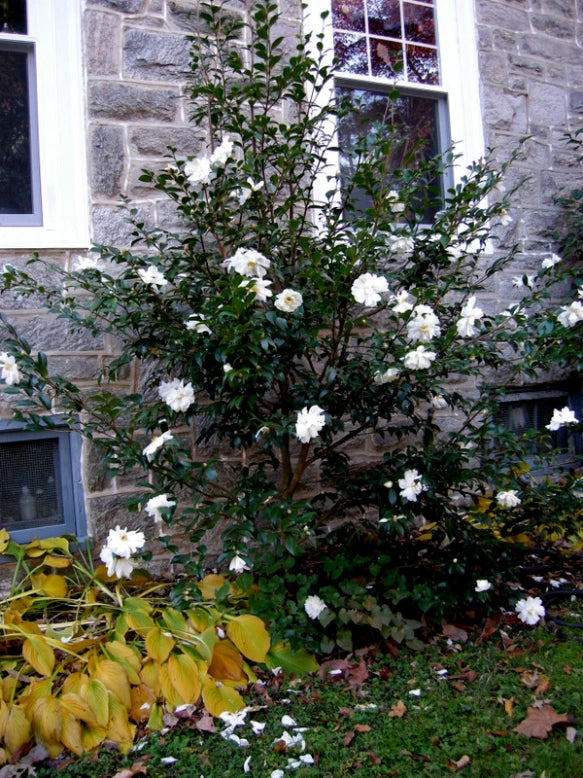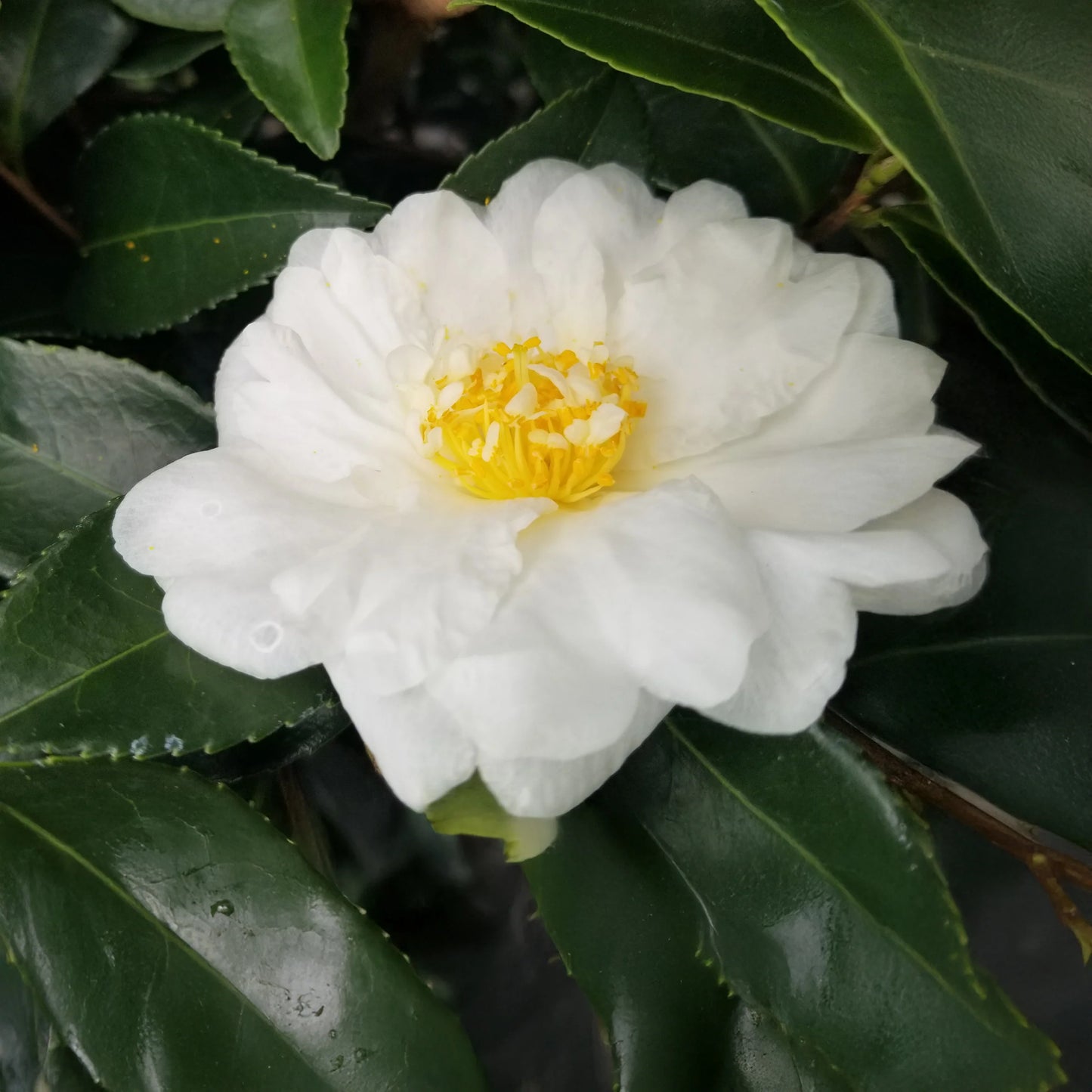My Store
Winter's Snowman Camellia
Winter's Snowman Camellia
Couldn't load pickup availability
Winter's Snowman Camellia - White Winter Blooming Evergreen
Experience the magic of pristine white flowers blooming in the depths of winter. The Winter's Snowman Camellia is a cold-hardy, evergreen flowering shrub celebrated for its stunning pure white blooms that illuminate the winter landscape when color is most precious. This extraordinary winter showpiece has become the premier choice for gardeners seeking elegant white flowers and reliable performance during the coldest months. With its luminous white petals and glossy dark green foliage, the Winter's Snowman Camellia transforms drab winter gardens into sophisticated displays of timeless beauty. The large, semi-double to peony-form blooms emerge abundantly from December through March, creating a striking contrast against winter's muted tones while providing year-round evergreen structure. Unlike delicate white-flowering shrubs that succumb to frost, these exceptionally hardy camellias deliver the pristine winter beauty you desire during the season when gardens need it most that actually becomes more spectacular as temperatures drop.
Why You'll Love the Winter's Snowman Camellia
Pure White Winter Drama: The profuse snow-white flowers with prominent yellow stamens reach 3–4 inches across on plants that mature at 6–8 feet tall and 5–6 feet wide, making this the perfect choice for elegant winter focal points, moonlight gardens, and formal landscapes where white blooms create stunning visual impact during the darkest season.
Outstanding Cold Tolerance: Space plants 4–6 feet apart for privacy screening or 6–8 feet apart for specimen displays, and they quickly develop into substantial evergreen structures with breathtaking winter flower shows. These cold-hardy white camellias have earned recognition as one of the most winter-resilient camellia varieties available, thriving in zone 6 where most camellias struggle.
Exceptionally Long Bloom Period: Resistant to flower damage from cold snaps and light freezes that ruin most winter-blooming plants. Once established, the Winter's Snowman Camellia produces wave after wave of pristine white blooms throughout winter, with flowers that remain beautiful even after frost and continue opening for 3–4 months straight.
Low-Care Elegance: A low-maintenance landscaping choice due to its glossy evergreen leaves that remain attractive year-round, naturally compact growth habit, excellent disease resistance, and shade tolerance - perfect for gardeners who want sophisticated white flowers and elegant structure without the demanding care that tender white-flowering shrubs require.
Winter's Snowman Camellia Details
- Botanical Name: Camellia oleifera 'Winter's Snowman'
- Type: Broadleaf evergreen flowering shrub
- Mature Size: 6–8 ft tall × 5–6 ft wide
- Growth Rate: Moderate — 6–12 inches per year
- Light: Partial shade to full shade
- Soil: Acidic, well-drained; organically rich
- Water: Moderate to high; consistent moisture required
- USDA Hardiness Zones: 6, 7, 8, 9
- Bloom Time: December through March
- Flower Color: Pure white with golden yellow stamens
Growing Conditions
Soil Adaptability: Winter's Snowman Camellia thrives in acidic soil with pH between 5.5–6.5, requiring organically rich, well-draining conditions similar to azaleas, rhododendrons, and other acid-loving plants. However, soil heavily amended with compost, peat moss, and aged pine bark produces the most prolific blooming and healthiest foliage, and neutral or alkaline soil must be corrected with sulfur and organic amendments or replaced in the planting area.
Light Requirements: Excels in partial shade to full shade (2–6 hours of dappled or morning sunlight). For optimal flower production and foliage quality, plant in locations with gentle morning sun and afternoon shade, or beneath the high canopy of pine or oak trees. Protection from intense afternoon sun and drying winter winds prevents leaf damage and helps flowers last longer during the blooming season.
Hardiness: Performs beautifully in USDA zones 6–9, making it suitable for gardens from the Mid-Atlantic states through the Deep South and into mild areas of the Pacific Coast, tolerating winter temperatures as low as -10°F. This exceptional cold hardiness places it among the toughest camellias available for northern gardens.
Care Instructions
Watering: Water deeply 2–3 times per week during the first two growing seasons to develop a robust root system that supports winter flowering. Once established, maintain even soil moisture throughout the year, particularly during fall when flower buds develop and winter when blooming occurs. Provide 1–2 inches of water weekly, increasing during dry spells or warm winters. Apply 3–4 inches of acidic mulch such as pine bark, pine straw, or shredded leaves to retain moisture and insulate roots.
Pruning: Prune immediately after the flowering period ends in early spring, before new growth emerges. Winter's Snowman Camellia requires only light pruning - remove spent flowers, dead or crossing branches, and shape gently to maintain desired form. Avoid pruning after late spring, as this removes the flower buds that form on new growth during summer and fall for the following winter's display.
Fertilizing: Apply an acid-loving plant fertilizer specially formulated for camellias and azaleas in early spring after blooming finishes and again in early to midsummer to support growth and bud formation. Use organic options like cottonseed meal or specialized camellia fertilizer according to package directions. Avoid fertilizing after August, which encourages tender late-season growth vulnerable to winter cold.
Landscaping Uses
Versatile Applications: Winter's Snowman Camellia's versatility makes it suitable for:
- Moonlight & White Gardens: The luminous white flowers practically glow in winter moonlight and low-angle sun, creating ethereal evening displays in monochromatic garden schemes
- Winter View Plantings: Position near patios, along walkways, or outside frequently used windows where the spectacular white blooms can be appreciated from warm indoor spaces during cold weather
- Shade Garden Focal Points: Provide dramatic winter interest and year-round evergreen structure in woodland gardens and shaded borders where few other plants offer flowers
- Foundation Plantings: Frame home exteriors with elegant evergreen presence on north and east exposures, with the bonus of winter white flowers
- Formal Landscapes: Ideal for estate gardens, traditional landscapes, and historic properties where white-flowering plants create sophisticated, timeless beauty
- Privacy Screens: Create medium-height evergreen hedges that provide year-round screening plus the unexpected delight of winter blooms
The Winter Garden Essential: Unlike spring and summer bloomers that leave your garden colorless during winter, the Winter's Snowman Camellia delivers its most spectacular display precisely when gardens are at their bleakest. The pure white flowers create stunning contrast against evergreen foliage and winter's neutral palette, while the glossy leaves provide year-round structure. It's one of the few shrubs that actually makes you look forward to winter, transforming cold months into a celebration of elegant white blooms.
Frequently Asked Questions
How far apart should I plant Winter's Snowman Camellia for a hedge or screen?
For an evergreen privacy screen or hedge, space plants 4–5 feet apart (center to center). For specimen plantings that showcase individual plants or mixed shade borders, space them 6–8 feet apart. Spacing at 4–5 feet creates a dense screen within 5–6 years while providing adequate air circulation to prevent disease. Remember that camellias appreciate good airflow and shouldn't be crowded.
When exactly does Winter's Snowman Camellia bloom, and how long do the flowers last?
Winter's Snowman Camellia typically begins blooming in December and continues through March, with peak flowering occurring in January and February depending on your location and weather. Individual flowers last 1–2 weeks, but the plant produces blooms continuously throughout the winter season, creating a 3–4 month display. The flowers are remarkably cold-tolerant and can withstand light frosts, though severe freezes in the low 20s°F may damage some blooms temporarily.
Can Winter's Snowman Camellia tolerate full sun, or does it need shade?
Winter's Snowman Camellia performs best in partial shade to full shade and generally should not be planted in full sun, especially in zones 7–9. Morning sun with afternoon shade is ideal, providing enough light for good flowering while protecting leaves and flowers from scorching. In zone 6, more sun exposure is tolerable if consistent moisture is provided, but afternoon shade is still preferable. Full sun exposure often results in stressed plants with pale, burned leaves.
What's the difference between Winter's Snowman and Winter's Joy Camellia?
Both are cold-hardy winter-blooming Camellia oleifera varieties, but Winter's Snowman features pure white flowers while Winter's Joy has rose-pink blooms. They have similar growth habits (6–8 feet tall), cold hardiness (zone 6–9), and bloom times (late fall through winter). Choose Winter's Snowman for white garden themes, formal landscapes, or moonlight gardens, and Winter's Joy for warmer color and fragrance. Both are equally cold-hardy and low-maintenance.
Share
